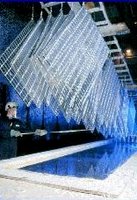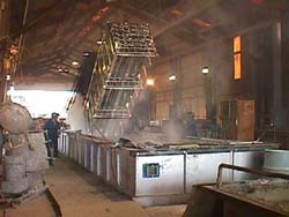


S.RAMESH
Email : ramee2k_in@yahoo.com
sramesh.tamiltrans@gmail.com
Ph: +919840836983www.doorstepz.com
SPECIFICATION / WORK INSTRUCTIONS FOR HOT-DIP GALVANISING OF IRON, STEEL SECTIONS / FABRICATIONS, CASTINGS ETC.
1. SCOPE : This standard specifies requirements for Hot-dip galvanised coatings on steel sections, fabrications, grey and malleable iron castings etc.
2. DEFINITION : A coating or zinc, and zinc iron alloy layers obtained by dipping prepared iron or steel components in molten zinc.
3. LIST OF INDIAN STANDARDS RECOMMENDED:
I) IS-2629 - Recommended practice for Hot-dip galvanising of
Iron or steel sections.
II) IS-4759 - Specification for Hot-dip coatings on structural steel
and other allied products.
III) IS-729 - Zinc for galvanising – specification
iv) IS-2633 - Method for testing uniformity of coating on zinc
coated articles.
v) IS-6745 - Method for determination of mass of zinc coating
on zinc coated iron and steel articles.
4. PREPARATION OF THE METAL SURFACE FOR GALVANISING:
4.1 Alkali degreasing -
Use the following special solvents to remove oil, grease, paint etc.
Use 10 to 15% Sodium hydroxide solution at 85 degree C to 90 degree C (or)
Use exclusive degreasing agents according to manufacturers requirement.
4.2 Acid pickling -
a) 10 to 15% HCL acids conform to IS-265.
b) Iron concentration should not exceed 7%.
After pickling, the components should be rinsed in running water.
NOTE: In case the components are heavily rusted, pitted, or with scales – to be cleaned property by sand blasting / shot blasting / fitting / wire brushing.
4.3.0 SPECIFICATION FOR ZINC - GRADE – Zn 98.5%
Zinc - 98.50% (min)
Lead - 1.25% (max)
Cadmium - 0.05% (max)
Iron - 0.05% (max)
Tin - 0.02% (max)
Copper - 0.02% (max)
Total impurities including above not to exceed 1.50%
4.3.1 PRE HEATING OF COMPONENTS - All the components to be thoroughly dried (Preheated) after fluxing using suitable means 120 degree C to 150 degree C.
4.3.2 GALVANISING BATH - The molten metal should contain 98.5% (min) of zinc by mass. Proper flux should be used for fluxing the components.
4.3.3 BATH TEMPERATURE
a) Normal Steels - 440 degree C to 450 degree C
b) High silicon steels - 540 degree C to 560 degree C
4.3.4 SUSPENDED DROSS - Dross should be allowed to settle at the bottom of the zinc baths and should not be disturbed more than necessary during dipping operation.
4.3.5 RATE OF IMMERSION - The work piece should be immersed as rapid as possible, but with due regard to operator’s safety.
4.3.6 TIME OF IMMERSION - The time of immersions depends on the temperature of the bath which is usually indicated by the stopping of the boiling action.
4.3.7 WATER QUENCHING - The Quench water to be changed frequently to prevent accumulation of chromium salts. (Running water is most preferred).
4.3.8 POST TREATMENT - All the components to be chromated after galvanising to retard white rust attraction. Chromating solution contains 1% Sodium Di-Chromate and 0.5% Sulphuric acid solution.
Temperature : Maximum 65 degree C.
4.3.9 STACKING – The galvanised articles should be allowed to dry before any further handling operation for stacking / storing.
5.0 TESTING AND INSPECTION
5.1 VISUAL EXAMINATION - Ensure quality of finish in line with the reference sample.
5.2 APPEARANCE OF THE COATING - The coating shall be smooth, continuous and free from flux, stain etc.
5.3 ADHESION OF THE COATING - The coating shall be sufficiently adherent to withstand for normal handling conditions without peeling or flacking.
5.4 UNIFORMITY IN THICKNES - Galvanised components shall be tested for uniform coating thickness in accordance to the following procedure.
Reagent - 360 gms copper sulphate in 1 Ltr distilled water
- Neutralization with copper carbonate 1 gm/ltr
- Allow the stand without disturbance atleast 24 hours and decanted from the sediment.
- Relative density 1.18 at 18 degree C + or – 2 degree C.
- The Cleaned test pieces shall be subjected to four successive dips of one minute each.
- After the above test, if a red deposit of metallic copper appears on the sample, such a deposit may be tested
for adhesive either by peeling or light rubbing.
- If the copper has been removed and zinc appears underneath the sample passes the test.
5.5 MASS OF COATING
-----------------------------------------------------------------------------------------------------
Category Minimum average Coating weight Coating thickness for
any individual test area of 600 to (min)
1200gms/sq.mtr
------------------------------------------------------------------------------------------------------
5mm thick and over 610.0 gms/Sq.mtr 86 microns
under 5mm but not less than 2mm 460.0 gms/Sq.mtr 65 microns
under 2mm but not less than 1mm 340.0 gms/Sq.mtr 48 microns
Grey and Malleable Iron Castings 610.0 gms/Sq.mtr 86 microns
5.6.1 DETERMINATION OF MASS OF COATING
5.6.1 STRIPPING SOLUTION
Dissolve 20 gms of antimony trioxide or 32 gms antimony trichloride in 1 Ltr of concentrated hydrochloric acid (Specific Gravity 1.56)
Immediately before test, prepare the stripping solution by addition of 5ml of the solution prepared as above to 100ml concentrated hydrochloric acid (Sp.Gravity 1.16) and mix well.
5.6.1. Test Sample – Weigh the sample 0.01 gms accuracy. Immerse the test piece in the test solution, until the coating has completely dissolved i.e. until the vigorous chemical action has ceased. Then the test piece shall be taken out, clean in water, wipe off well with clean soft cotton cloth, dry fully and weigh again.
5.6.2. Calculation:
M1 – M2 6
M = ------------------- X 10
A
Where M = Mass of Zinc coating in gms/sq. mtr of surface
M1 = Initial mass of the test piece
M2 = Mass of the stripped test piece
A = Total area of the stripped test piece in sq.mm
for more details contact:-
S.Ramesh
+919840836983
ramee2k_in@yahoo.com
www.doorstepz.com
(An online exclusive shopping portal - Anything, Anywhere)-------------------------------------------------------------------------------------------------------
